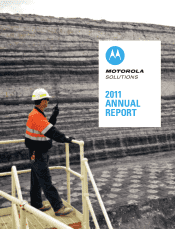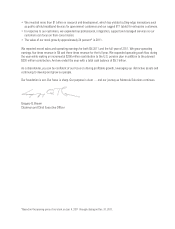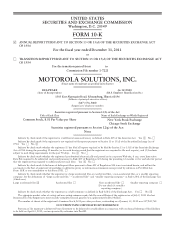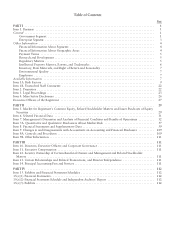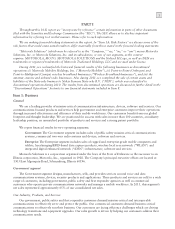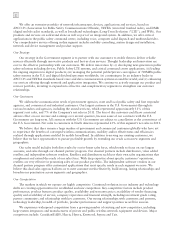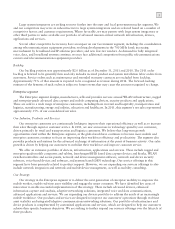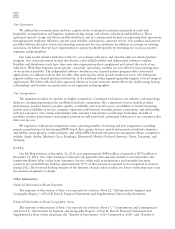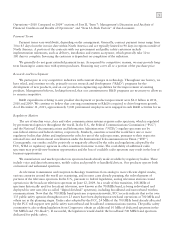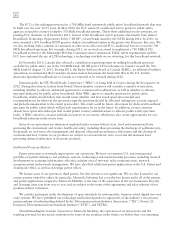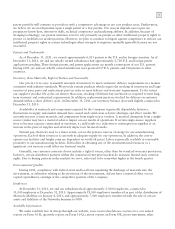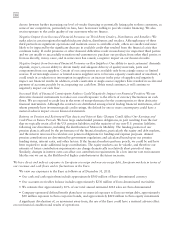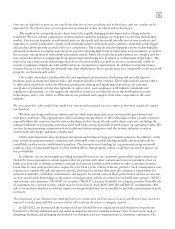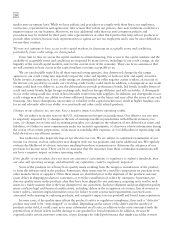Motorola 2011 Annual Report Download - page 11
Download and view the complete annual report
Please find page 11 of the 2011 Motorola annual report below. You can navigate through the pages in the report by either clicking on the pages listed below, or by using the keyword search tool below to find specific information within the annual report.
5
Operations—2010 Compared to 2009” sections of Part II, “Item 7: Management’s Discussion and Analysis of
Financial Condition and Results of Operations” and “Item 1A: Risk Factors” of this document.
Payment Terms
Payment terms vary worldwide, depending on the arrangement. Generally, contract payment terms range from
30 to 45 days from the invoice date within North America and are typically limited to 90 days in regions outside of
North America. A portion of the contracts with our government and public safety customers include
implementation milestones, such as delivery, installation and system acceptance, which generally take 30 to
180 days to complete. Invoicing the customer is dependent on completion of the milestone.
We generally do not grant extended payment terms. As required for competitive reasons, we may provide long-
term financing in connection with system purchases. Financing may cover all or a portion of the purchase price.
Research and Development
We participate in very competitive industries with constant changes in technology. Throughout our history, we
have relied, and continue to rely, primarily on our research and development (“R&D”) programs for the
development of new products, and on our production engineering capabilities for the improvement of existing
products. Management believes, looking forward, that our commitment to R&D programs are necessary to allow us
to remain competitive.
R&D expenditures relating to new product development or product improvement were $1.0 billion in 2011,
2010 and 2009. We continue to believe that a strong commitment to R&D is required to drive long-term growth.
As of December 31, 2011, approximately 7,000 professional employees were engaged in such R&D activities for us.
Regulatory Matters
The use of wireless voice, data and video communications systems requires radio spectrum, which is regulated
by governmental agencies throughout the world. In the U.S., the Federal Communications Commission (“FCC”)
and the National Telecommunications and Information Administration (“NTIA”) regulate spectrum use by
non-federal entities and federal entities, respectively. Similarly, countries around the world have one or more
regulatory bodies that define and implement the rules for use of the radio spectrum, pursuant to their respective
national laws and international coordination under the International Telecommunications Union (“ITU”).
Consequently, our results could be positively or negatively affected by the rules and regulations adopted by the
FCC, NTIA or regulatory agencies in other countries from time to time. The availability of additional radio
spectrum may provide new business opportunities and the loss of available radio spectrum may result in the loss of
business opportunities.
We manufacture and market products in spectrum bands already made available by regulatory bodies. These
include voice and data infrastructure, mobile radios and portable or handheld devices. Our products operate both
on licensed and unlicensed spectrum.
As television transmission and reception technology transitions from analog to more efficient digital modes,
various countries around the world are examining, and in some cases already pursuing, the redevelopment of
portions of the television spectrum. In the U.S., pursuant to federal legislation, analog television stations ceased
operation in the broadcast television spectrum on June 12, 2009. As a result of this transition, 108 MHz of
spectrum historically used for broadcast television, now known as the 700MHz band, is being redeveloped and
deployed for new uses (the so-called “digital dividend” spectrum), including broadband and narrowband wireless
communications. Now that the 700 MHz band spectrum is open nationwide, FCC records indicate that so far over
135 public safety agencies throughout over 25 states have been deploying narrowband operations at 700 MHz and
others are in the planning stages. Under rules adopted by the FCC, 24 MHz of the 700 MHz band already allocated
by the FCC will support new public safety narrowband and broadband communications systems. The public safety
community is also seeking legislation from Congress to obtain an additional 10 MHz of dedicated spectrum in the
700 MHz band (“D-block”). If successful, the legislation would double the broadband 700 MHz band spectrum
dedicated for public safety.

